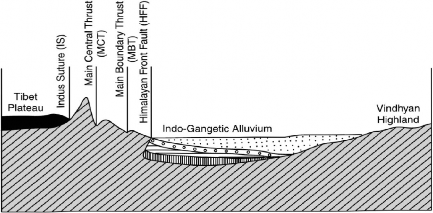2. Infilling of a Rift Valley
In the opinion of Sir G. Burrard, the Northern Plains of India are the result of infilling of a rift valley. Burrard opined that during the formation of the Himalayas a rift valley was created between the two parallel faults (one along the southern boundary of the Shiwaliks and the other along the northern boundary of the Peninsula). This rift valley was filled up by the detritus brought down by the Himalayan rivers. In order to support his argument Burrard has cited examples of the formation of similar rift valleys in the I limalayas and the Peninsular region especially the Narmada and Tapi rift valleys.
This concept, however, does not find approval of the modern geologists. The main criticism raised against this concept is that nowhere in the world has such a giant rift valley with a length of 2400 km and a width of over 500 km ever been formed by crustal downwarping. Also, there is no geological evidence of the formation of such a rift valley in the northern part of the Peninsular foreland. The uneven bottom and the northward slope of the bottom of the Great Plains of India have also not been explained by this concept.

